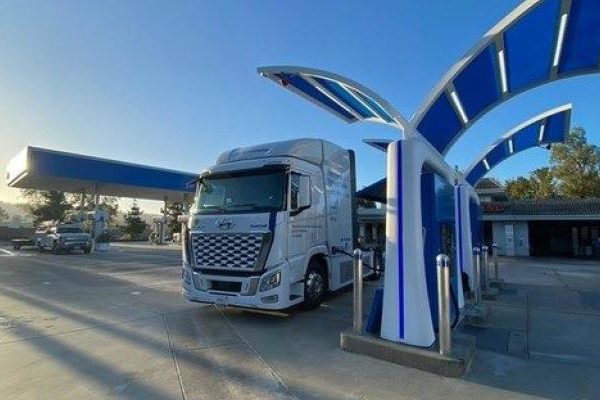
Energy Secretary Jennifer Granholm and other officials outline takeaways on new “clean” hydrogen and natural gas reports.
A Department of Energy advisory committee said Tuesday that the nascent “clean” hydrogen industry is not growing fast enough to meet U.S. climate goals, a conclusion that Energy Secretary Jennifer Granholm called “sobering.”
According to a new report from the National Petroleum Council (NPC), the hydrogen industry won’t generate enough supply and demand for the emerging low-to-zero carbon fuel to help the U.S. achieve net-zero emissions by 2050 under current federal policies.
The council makes recommendations to the Energy secretary on oil and natural gas issues. NPC’s hydrogen report was released Tuesday along with another report from the council focused on reducing U.S. natural gas supply chain emissions.
It found that under an existing policies path, where current policies and regulatory actions are implemented, a 59 percent reduction in methane emissions from America’s natural gas supply chain can be achieved by 2050 — but that carbon dioxide emissions would go up by 25 percent because under the current pathway CO2 isn’t prioritized to the same degree as methane.
In the reports, NPC calls for policymakers to help facilitate hydrogen production and sales, while seeking improved efforts to curb emissions from the production and delivery of natural gas.
Granholm requested the studies in two separate letters to the NPC: first, in November 2021 — asking the council to conduct a study “on the deployment of low and zero carbon hydrogen energy at scale” — and then in April 2022, requesting a study “that defines pathways” for reducing greenhouse gas emissions across the U.S. natural gas value chain.
Hydrogen is “one of those sectors and technologies that is not on track” to meet net-zero goals, Deputy Energy Secretary David Turk said Tuesday. But that “doesn’t mean we’re not making progress,” he added.
The NPC voted Tuesday to approve the studies on hydrogen and reducing emissions from U.S. natural gas, providing both industries — as well as public officials and advocacy groups — with a range of recommendations intended to curb carbon dioxide and methane emissions and bolster hydrogen production.
The NPC has more than 200 members, primarily from the oil and gas industry, as well as some electric companies, research groups and academic institutions.
The studies come as the White House has directed $8 billion in 2021 bipartisan infrastructure law funding toward regional “clean” hydrogen hubs to attract even greater private investment and as the administration continues to roll out regulations that go after emissions of methane — a potent greenhouse gas — from the U.S. oil and gas sector.
In remarks to the NPC on Tuesday, Granholm said that some people may prefer to stick to the energy “status quo” and may “think that a fight is more productive than progress.” She said the Biden administration doesn’t see it that way, adding that “hopefully” members of the NPC don’t either.
A DOE spokesperson did not return a request for comment Tuesday on how Granholm defines the energy “status quo.”
“Because we all know this — that in five years or 10 years, 20 years, the energy status quo is going to be obsolete,” Granholm said. “For those who are proclaiming the future with certainty, I think a little humility is in order.”
While “secure supplies of traditional energy” will still be needed, Granholm said, “consumers and communities and countries and investors who are calling for change today will have fundamentally reshaped the markets tomorrow.”
In a news conference after the study presentations, Williams Cos. CEO Alan Armstrong responded by echoing the uncertainty of the future.
“I completely agree that none of us know exactly what the future looks like for energy in 20 years,” said Armstrong, chair of the NPC. “But I will say that what we have to do today is work on the practical, pragmatic solutions that we have available to us today to reduce emissions.”
Hydrogen woes
The hydrogen industry needs additional federal support in order to reach levels required to achieve net-zero U.S. carbon emissions by 2050, according to the NPC hydrogen report.
Current federal policies — including a lucrative tax credit from the 2022 Inflation Reduction Act and hydrogen hubs funded by the 2021 bipartisan infrastructure law — would roughly double annual hydrogen production and demand by 2050 from about 11 million metric tons per year in 2021, NPC said in the report.
But U.S. hydrogen production and demand need to increase roughly sevenfold from 2021 levels to 75 million metric tons per year in 2050 to achieve net-zero U.S carbon emissions. Most hydrogen fuel produced today is made from natural gas without capturing emissions, and it would need to cut significantly emissions in a net-zero scenario, according to the report.
Emerging “green” hydrogen made from renewable-powered electricity needs $1.8 trillion in capital investment between now and 2050 to support the 2050 goal. “Blue” hydrogen made from fossil fuels and carbon capture needs $100 billion in investment to do the same.
The net-zero emissions scenario in the NPC report assumes clean hydrogen can slash up to 8 percent of total U.S. carbon emissions, primarily in the industrial manufacturing sector. In that scenario, green hydrogen becomes more prominent than blue hydrogen.
NPC offered 23 specific recommendations to help the hydrogen industry develop over the next three decades. They broadly call for policymakers to facilitate the production and purchase of hydrogen, increase public acceptance of hydrogen fuel, and back research and development efforts.
NPC called on Congress to extend the lifetime of hydrogen tax subsidies known as 45V, which expire at the end of 2032, for example. NPC intentionally did not weigh in on 45V’s contentious method to account for the emissions of hydrogen made from grid electricity.
“The study participants, with the diversity of the group that we had, could not agree to every aspect of what good rulemaking would look like in 45V,” said Austin Knight, vice president of hydrogen for Chevron New Energies, on Tuesday.
The report also calls for Congress to fund hydrogen infrastructure such as pipelines and federal officials to investigate hydrogen supply chain problems.
Natural gas
While U.S. natural gas is important from an energy security standpoint and can displace coal in power generation, the NPC report found that emissions from its supply chain present a challenge.
Emissions from the natural gas supply chain, inclusive of crude oil and natural gas liquids, account for 33 percent of all U.S. methane emissions, 5 percent of the country’s carbon dioxide emissions, and 8 percent of total U.S. greenhouse gas emissions.
Methane has about 80 times the heat-trapping power of CO2 over its first 20 years in the atmosphere.
The “current trajectory does not prioritize carbon dioxide (CO2) emissions to the same degree,” as methane, according to an NPC fact sheet, referring to the existing policies pathway.
If there are significant policy advancements and a large build-out of infrastructure for emission-reductions projects such as carbon capture and storage, methane emissions from the natural gas supply chain could fall by an estimated 70 percent and CO2 emissions could decline by 33 percent through 2050, the report found.
The infrastructure build-out under that pathway also requires increased electrification.
Cutting emissions from natural gas is “an urgent priority that requires collaborative solutions and there is a lot of work to be done,” said Ryan Lance, CEO of ConocoPhillips and vice chair of the NPC, at the council meeting.
“But thanks to the study, we have the tools and framework to make a difference and we can make a very real impact,” Lance continued.
The report offers dozens of findings and recommendations, including a call for a White House methane task force to work with federal agencies to “harmonize emissions reporting” and control requirements across the federal government.
Other recommendations include having industry trade associations continue to develop community engagement training programs and DOE commissioning a workforce study centered on the “mismatch of current skills” versus skills needed for emissions reduction projects on natural gas.
On Tuesday, DOE’s Turk pointed to the oil and gas sector’s previous work on addressing methane, adding that tackling those emissions is “the single biggest no brainer to all get our acts together on this front. I know you all know that, and I think this report is terrific analysis to get on with it.”
“We just need to get on with this, at scale, at pace, and reduce our emissions,” Turk said.
At Tuesday’s news conference, ConocoPhillips’ Lance said he didn’t disagree with Turk.
“I actually think the industry is getting on with it, today,” Lance said. “I think there’s some interest in moving at quicker a pace — people have been waiting on some of the EPA regulations that are coming out, to understand that, but I think companies like ours and companies across the industry are already utilizing the technologies that exist today.”
SOURCE: E&E NEWS
Read the most up to date Fuel Cell and Hydrogen Industry news at FuelCellsWorks




